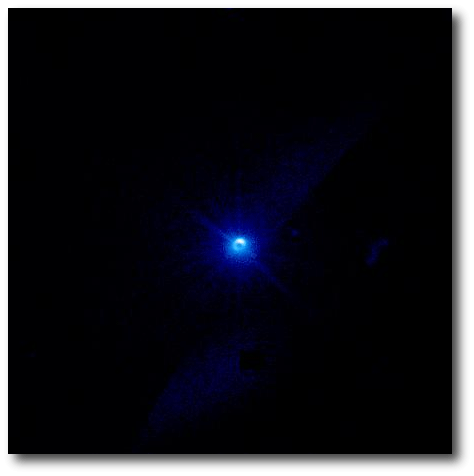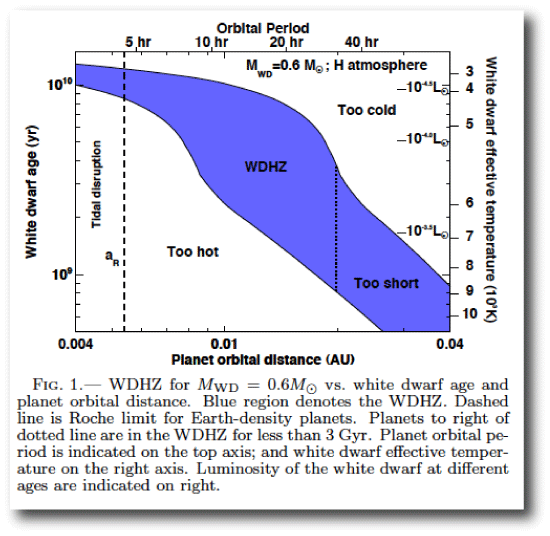
Galex Far-UV survey image centered on 40 Eridani B.
Like many kids, I enjoyed reading The Magician’s Nephew by C. S. Lewis. Especially evocative were the descriptions of the dying planet Charn:
The wind that blew in their faces was cold, yet somehow stale. They were looking from a high terrace and there was a great landscape spread out below them.
Low down and near the horizon hung a great red sun, far bigger than our sun. Digory felt at once that it was also older than ours: a sun near the end of its life, weary of looking down upon that world. To the left of the sun, and higher up, there was a single star, big and bright. Those were the only two things to be seen in the dark sky; they made a dismal group. And on the earth in every direction, as far as the eye could reach, there spread a vast city in which there was no living thing to be seen.
The story was written in the early 1950s, just as the future evolution of the Sun was beginning to be understood, but before the Henyey technique for computing full stellar evolutionary sequences had been developed. The scene, while compelling, seems to make little astrophysical sense. It describes a parent star on its ascent of the red giant branch, yet the star’s overall luminosity seems clearly on the wane. In truth, as a red giant swells up, its overall luminosity increases drastically, and the end game for habitable planets consists of fire rather than ice.
Earlier this year, however, there was a very interesting paper by Eric Agol that discusses the possibility of Earth-like planets orbiting white dwarf stars. These planets, if they exist, would be spin-synchronized and would have orbital periods of order 10-20 hours. On such a world, the demise of habitability occurs as the parent white dwarf loses its heat of formation, and grows gradually redder, even as it maintains the same angular size in its fixed position in the sky.
Here’s the relevant summary diagram from Agol’s paper. As the parent white dwarf cools, it travels vertically up the plot.

Now admittedly, this set-up is sailing pretty close to the wind. Indeed, I’ve largely come to adopt the opinion that the whole idea of the “habitable zone” is the modern-day equivalent of Bode’s Law. And furthermore, it’s not exactly clear how one might arrange for habitable planets to be orbiting white dwarfs. The reason I’m enthusiastic is that Agol’s scenario is eminently testable. If white dwarfs harbor Earth-sized planets in quantity, then they can potentially be discovered by backyard astronomers. A one-Earth radius planet on an a=0.013 AU orbit around a typical 0.6 solar-mass white dwarf produces a central transit depth of ~50% during a transit that lasts one or two minutes.
Bruce Gary, who has been a leader in the area of transit detection using small telescopes, has recently organized a pilot photometric project to detect transiting planets orbiting white dwarfs. Here’s his description of the project from an announcement that he sent around last week:
All,
This is a “call for observers” for a 1-month project to evaluate feasibility of amateurs and others to detect white dwarf transits using available hardware.
This should be viewed as a “pilot project” designed to provide a first evaluation of the abundance of exoplanets orbiting white dwarfs in short-period orbits (near the habitable zone). It can play a role in designing a funded project using professional hardware to conduct a long-term and more comprehensive white dwarf (WD) transit search. Professional astronomer guidance is provided by Prof. Eric Agol, who has written several articles on the subject of exoplanets in WD habitable zones. I will archive light curves at a web site in a manner similar to what I did for the Amateur Exoplanet Archive (AXA).
I have tentatively identified September as the observing month. Coordinated observing by partners is encouraged to permit corroboration of any interesting light curve feature. Note that since WDs are very small, comparable to the Earth, a central crossing by an Earth-size exoplanet will produce a very deep transit feature, possibly causing a temporary complete fade. Another consequence of the small size is that transit lengths will be short, typically a couple minutes. In spite of the great depth the search for WD transits is an observational challenge because of the short length. The chance of success in detecting a WD transit may be small but the payoffs for success are great!
Anyone with experience observing exoplanet transits is qualified for this project. However, of the known 20,000 or so WDs only 168 are brighter than V-mag = 14.0. This means that telescope aperture matters, and for most WD targets an aperture of at least 10 inches will be needed.
The project will go by the name Pro-Am White dwarf Monitoring, or PAWM. A description of PAWM can be found at the following web site: http://brucegary.net/WDE/
Please forward this e-mail to anyone who might be interested in participating as an observer or professional adviser. Reply to this e-mail if you would like to receive occasional updates on PAWM.
Bruce L. Gary
Hereford Arizona Observatory
A very exciting project! Once September starts, I’ll be checking the PAWM site to watch how the survey unfolds…

Greg,
don’t wait until September, there is some activity already.
http://brucegary.net/WDE/
Joao Gregorio
Pingback: Populär Astronomi - » Har vita dvärgar planeter? Amatörer och proffs söker svaret
Given the faintness of the targets and the short duration of the eclipses, this seems as though it’s a consideraly HARDER project than doing the exoplanet transit work that high level amateurs (I like to call them “semi-pros”) have already done. Even the white dwarf-red dwarf system V471 Tauri didn’t have a very well sampled eclipse until observations from orbit by MOST. Plus, if earth sized planets were common, wouldn’t the high time resolution observations made of oscillating white dwarfs have already found them? Certainly placing some limits on their existence should be possible by examining that data.
Pingback: Nachrichten aus der Astronomie kompakt « Skyweek Zwei Punkt Null
Regarding getting the planets there in the first place, is there any evidence of fallback discs around young white dwarf stars? Otherwise I guess second-generation planet formation (Mira B?) might work…